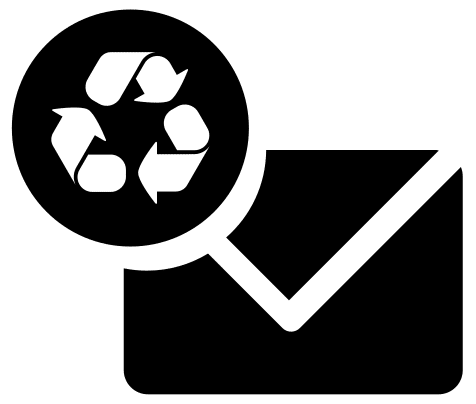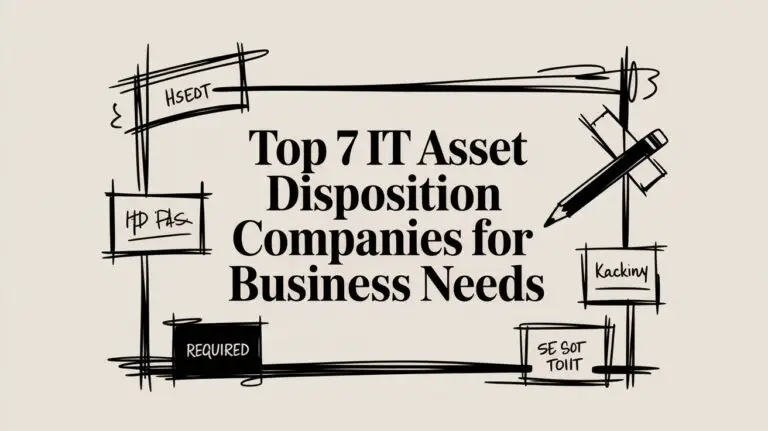When a business in the United States hears "IT Asset Disposition" or ITAD, it's easy to think it's just a fancy term for throwing away old computers. But for a commercial enterprise, it's so much more than that. Think of it as a strategic, documented process for securely and sustainably retiring your company's unwanted, obsolete, or end-of-life technology, including servers, laptops, medical equipment, and data center hardware.
This isn't just about hauling away old hardware. For any business, ITAD is a crucial final stage in an equipment's lifecycle, designed to shield your organization from data breaches, maximize financial value from used assets, and ensure compliance with environmental and data privacy laws. It's an absolute must for any U.S. company upgrading its tech, decommissioning a data center, or managing hardware that's reached the end of its useful life.
Demystifying IT Asset Disposition for Your Company
At its heart, ITAD is a structured, responsible process to manage the final chapter of your company's technology assets. This is not "taking out the trash"—this is a critical business function for decommissioning corporate infrastructure. Every single server, laptop, and network switch holds sensitive company or customer data, making each one a potential liability if not handled correctly through a professional service.
A solid ITAD strategy isn't just an expense; it's a core risk management function that addresses three critical concerns for any business:
- Data Security: Keeping sensitive corporate and customer information locked down is non-negotiable. A single hard drive that's improperly discarded can trigger a catastrophic data breach, destroying your company's finances and reputation.
- Financial Recovery: You'd be surprised how much value is left in your retired IT assets. A professional ITAD program can turn that old equipment—from laptops to laboratory equipment—into cash by refurbishing and reselling it.
- Regulatory Compliance: The list of rules for U.S. businesses keeps growing. Companies must navigate a maze of environmental and data privacy laws, like the FTC Disposal Rule, HIPAA, and various state-level e-waste regulations.
The Scope of ITAD Services
So, what does this process actually look like for a business? It’s a comprehensive system that goes way beyond basic electronics recycling. A certified ITAD partner like Beyond Surplus manages every single step, ensuring a secure and documented chain of custody from the moment the equipment leaves your office, data center, or facility.
You can dive deeper into the full journey in our guide on the importance and process of IT asset disposition.
The entire point of a commercial ITAD service is to minimize business risk while maximizing financial value. When you formalize how your company retires its assets, you protect your data, stay compliant, and recover money from hardware you might have otherwise considered a total loss.
To better understand the key stages, let's break down the process into its core components.
Core Components of the IT Asset Disposition Process
A comprehensive ITAD strategy involves several distinct stages, each with a specific goal to ensure a secure, compliant, and value-driven outcome. The table below outlines these essential steps for business clients.
| ITAD Stage | Primary Objective for Businesses | Key Activities |
|---|---|---|
| Logistics & Collection | Securely transport assets from the client's site. | On-site packing, serialized inventory creation, secure transportation. |
| Data Destruction | Eradicate all sensitive data from storage devices. | Certified data wiping, physical shredding (on-site or off-site). |
| Asset Processing | Test, grade, and prepare assets for their next destination. | Functional testing, cosmetic grading, component harvesting. |
| Value Recovery | Maximize financial return from functional equipment. | Refurbishment, resale through established secondary markets. |
| Responsible Recycling | Ensure non-functional assets are disposed of ethically. | Dismantling, material separation, certified e-waste recycling. |
| Reporting & Certification | Provide a documented audit trail for compliance. | Certificates of Data Destruction, detailed asset reports. |
Each step is critical for building a defensible and transparent disposition program that protects your organization from start to finish.
Why It Is Not Just an IT Problem
In the past, getting rid of old tech was often a task dumped on the IT department's plate. Not anymore. For modern businesses, the consequences of getting it wrong now ripple through the entire organization.
Your legal team is worried about compliance. The finance department wants to see value recovery. And company leadership is intensely focused on protecting the brand's reputation.
This is why a professional ITAD program is a vital risk management tool. It gives your business documented proof of data destruction and environmentally sound recycling, shifting the liability from your shoulders to a certified expert. Without a proper plan, your company is left wide open to major security threats and steep legal fines.
The Step-By-Step ITAD Journey for Your Business Assets
Ever wonder what actually happens to your old corporate equipment after it leaves your office? The IT asset disposition (ITAD) process is far more than just a pickup service. It's a carefully managed journey designed to shield your business data, reclaim value from old gear, and keep your company compliant with environmental laws every step of the way.
It all starts the moment a certified ITAD partner walks through your door and hinges on one critical concept: an unbroken chain of custody. Think of it as a documented, chronological paper trail that tracks every single asset from your facility to its final destination. Every item is scanned and tracked by its serial number, ensuring nothing mysteriously vanishes along the way.
Phase 1: Secure Logistics and Initial Processing
The first physical step is the secure collection and transport of your assets. This isn't your average moving job; it's a security operation. Professional ITAD teams use specialized equipment and secure vehicles to handle everything from bulky data center servers and laptops to sensitive medical and lab equipment.
Once the assets reach a secure facility, they’re immediately checked in against the initial inventory list. This reconciliation confirms that every piece of equipment that left your building has arrived safely, reinforcing that crucial chain of custody. During transitions, it's also important that businesses are storing electronics safely to prevent damage or security risks before final processing.
Phase 2: The Critical Data Destruction Stage
This is arguably the most important phase of the entire ITAD journey for any business. Hitting 'delete' on a file doesn't cut it—that data is often easily recoverable. Professional data destruction ensures that every bit of corporate information is permanently and irretrievably wiped clean.
You have several certified methods to choose from, depending on your company's security needs:
- Software-Based Data Wiping: This method uses specialized software to overwrite a hard drive's data with random characters, often multiple times. It follows strict standards like the NIST 800-88 guidelines, which makes the original data impossible to recover while leaving the physical drive intact for reuse and value recovery.
- Degaussing: Perfect for magnetic media like older hard disk drives (HDDs) and backup tapes, degaussing uses a powerful magnetic field to instantly scramble and destroy all data. It's fast and absolute, but it also renders the drive unusable.
- Physical Shredding: For the highest level of security or for non-functional devices, nothing beats physical destruction. Industrial shredders grind hard drives, solid-state drives (SSDs), and other media into tiny, unrecognizable pieces, making data recovery physically impossible.
After your data is destroyed, you’ll receive a Certificate of Data Destruction. This document is your official legal proof that the data has been securely eliminated. It's essential for passing audits and formally transfers liability from your company to the ITAD vendor.
This infographic gives you a bird's-eye view of the ITAD process flow, from securing your assets to recovering their value and recycling what's left.
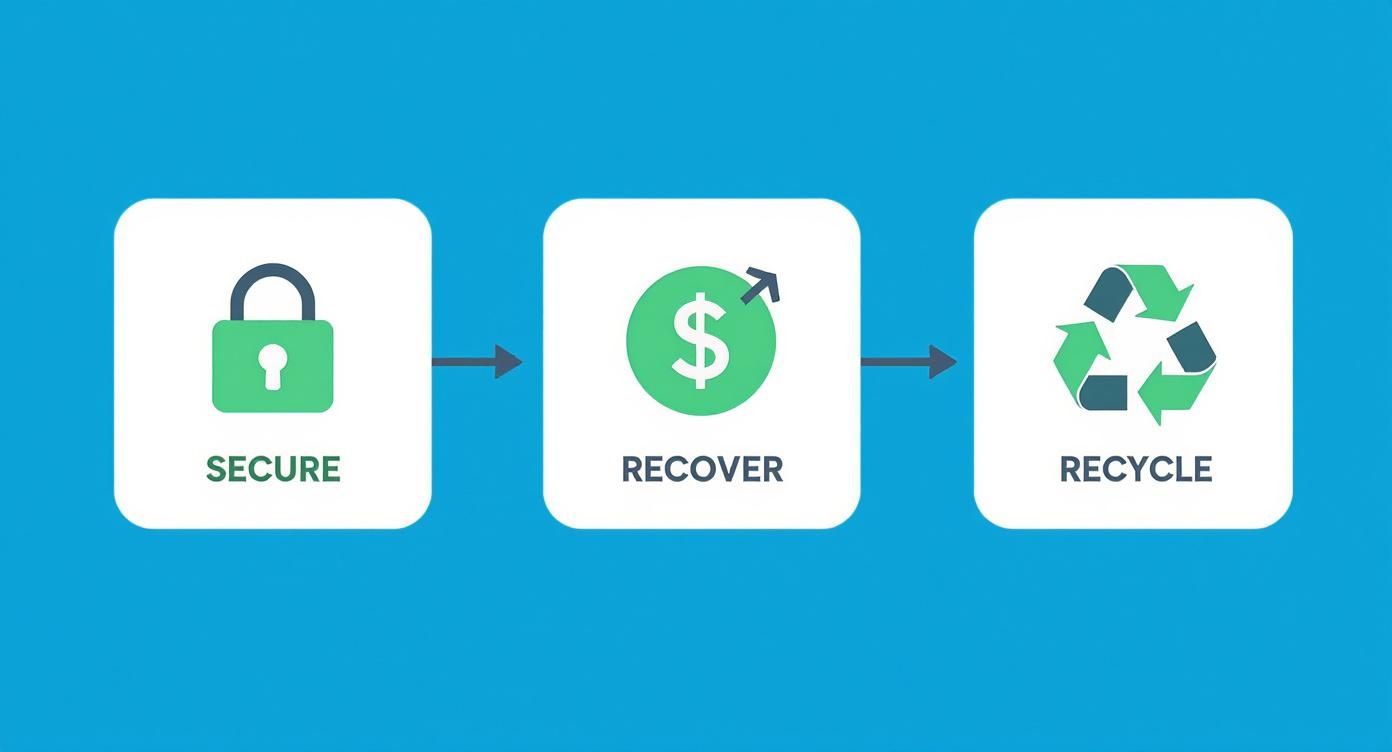
It clarifies how a structured program moves from strict security protocols to financial returns and, finally, to environmentally sound recycling.
Phase 3: Asset Auditing and Value Recovery
Just because the data is gone doesn't mean the journey is over. Next, each asset is thoroughly audited, tested, and graded based on its condition, age, and functionality. This detailed evaluation determines if it can be remarketed to recover value for your business.
Equipment that still has market value—like newer servers, networking gear, or enterprise-grade laptops—is refurbished and prepped for resale. This value recovery process can generate a surprising financial return for your company, turning a disposal cost into a revenue stream. You'll get a detailed report breaking down exactly what was sold and the value you recovered.
Phase 4: Responsible E-Waste Recycling
For any assets that are too old, broken, or simply have no resale value, the final stop is responsible recycling. This is where the environmental promise of ITAD comes to life for your corporate responsibility goals.
Certified e-waste recyclers de-manufacture the equipment, carefully breaking it down into its core materials like plastic, steel, aluminum, and precious metals. These commodities are then funneled back into the manufacturing supply chain. This circular approach keeps hazardous materials out of landfills and ensures your company meets all environmental regulations, protecting your reputation as a responsible corporate citizen.
Protecting Your Business with Compliant ITAD
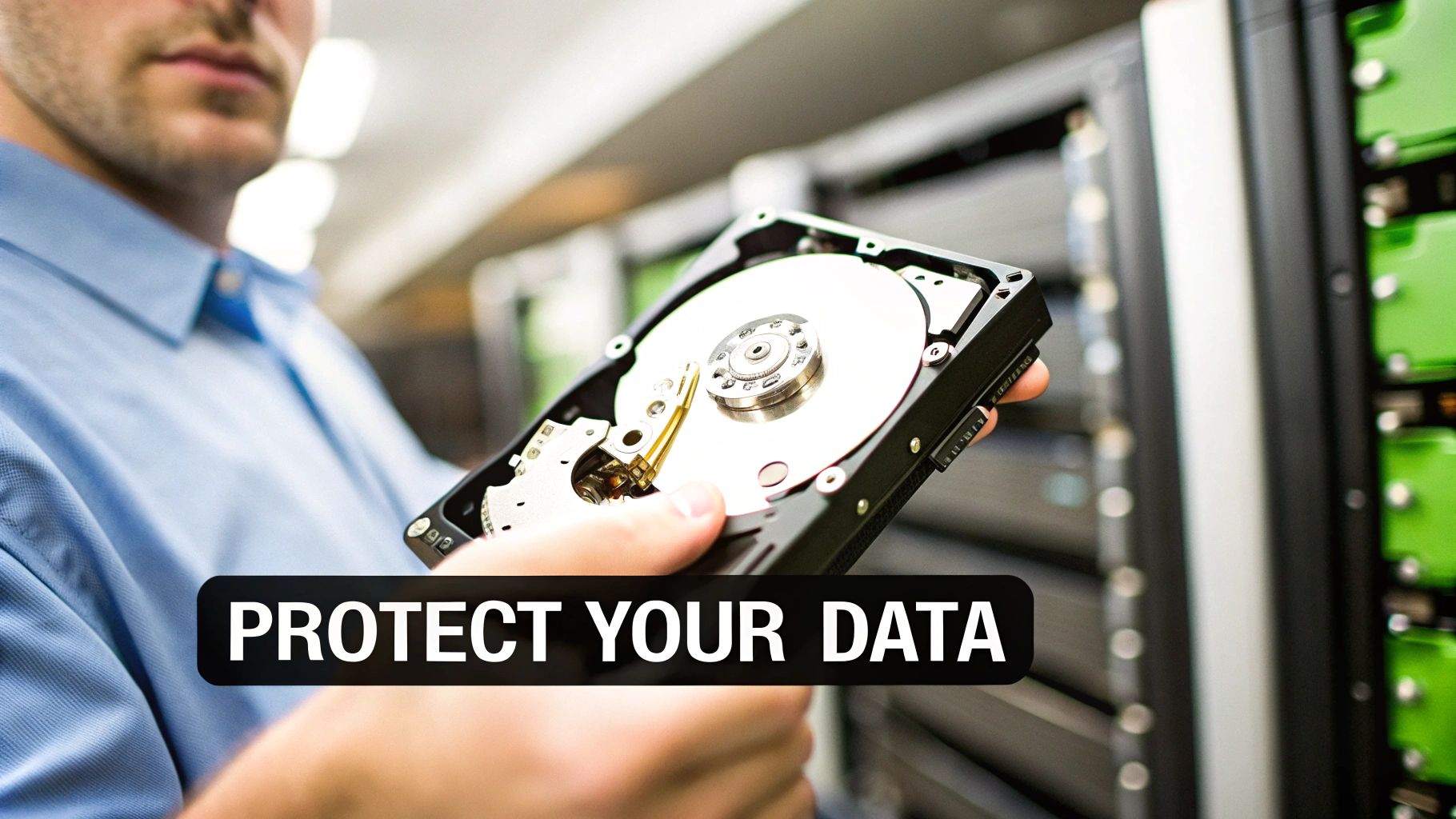
So we've covered the "how" of ITAD, but it's just as important for U.S. businesses to understand the urgent "why." Handing off old corporate equipment isn't just a logistical task; it’s a critical business decision packed with risk. If you don't handle it right, you're not just being wasteful—you're opening your company up to serious, often overlooked, dangers. The real-world consequences can hit everything from your bottom line to your hard-earned reputation.
Think about it: a single hard drive you thought was obsolete can hold a goldmine of sensitive information. We're talking customer lists, employee records, and confidential company secrets. If that data ends up in the wrong hands, that old piece of hardware can quickly become a multi-million dollar liability.
The High Cost of Cutting Corners
Federal and state governments aren't messing around when it comes to data privacy and e-waste. They’ve put strict rules in place, and simply ignoring them isn't an option for any commercial entity. Doing so exposes your organization to some pretty hefty legal and financial heat.
A professional ITAD program is your business's first line of defense, making sure you stay on the right side of these complex requirements.
Think of compliant ITAD as a corporate insurance policy. It's an indispensable component of your risk management strategy that protects your customer data, safeguards your brand, and secures your bottom line from the severe consequences of a data breach.
Several key regulations directly shape how your business should be handling old IT gear:
- Health Insurance Portability and Accountability Act (HIPAA): This is a big one for any business in healthcare. HIPAA demands that all protected health information (PHI) is made completely unreadable before a device is retired. Get this wrong, and you could be looking at fines running into the millions.
- Gramm-Leach-Bliley Act (GLBA): If you're in the financial world, GLBA requires you to protect your customers' private financial data. That means having a rock-solid plan for securely disposing of any digital records.
- FTC Disposal Rule: This rule is straightforward—businesses must take proper steps to get rid of sensitive information from consumer reports. Just tossing old hard drives in a dumpster is a clear violation.
- General Data Protection Regulation (GDPR): For any company holding data on EU citizens, the GDPR is non-negotiable. A data breach from improper disposal can trigger massive fines, up to 4% of your annual global turnover.
Failing to follow these rules can lead to crippling penalties, forced public announcements about data breaches, and a loss of customer trust that can take years to rebuild.
When ITAD Goes Wrong: Real-World Business Scenarios
To really get a feel for the risk, let's look at some commercial examples. Imagine a hospital sends a stack of old computers to a local, uncertified recycler. If even one hard drive still has accessible patient files, that hospital is facing a massive HIPAA violation, triggering government investigations and painful fines.
Or consider a financial advisory firm that gets rid of old office laptops without getting them professionally wiped. If client investment details are exposed, the resulting GLBA breach would not only mean fines but could completely shatter the firm’s credibility. For a closer look at what certified data cleaning involves, check out our overview of effective data destruction for IT equipment.
These aren't just scary stories; they happen all the time to businesses that don't take ITAD seriously. Your liability doesn't just vanish once the equipment leaves your office. Without a certified process and a clear chain of custody document, your organization is still on the hook for any data leaks.
Beyond data security, proper ITAD is also about being environmentally responsible. This a guide on how to reduce electronic waste offers more insight into doing it right. When you partner with a certified ITAD provider like Beyond Surplus, you effectively transfer that liability and get the documentation to prove your assets were handled securely and sustainably from start to finish.
Turning Old Tech into New Revenue for Your Business
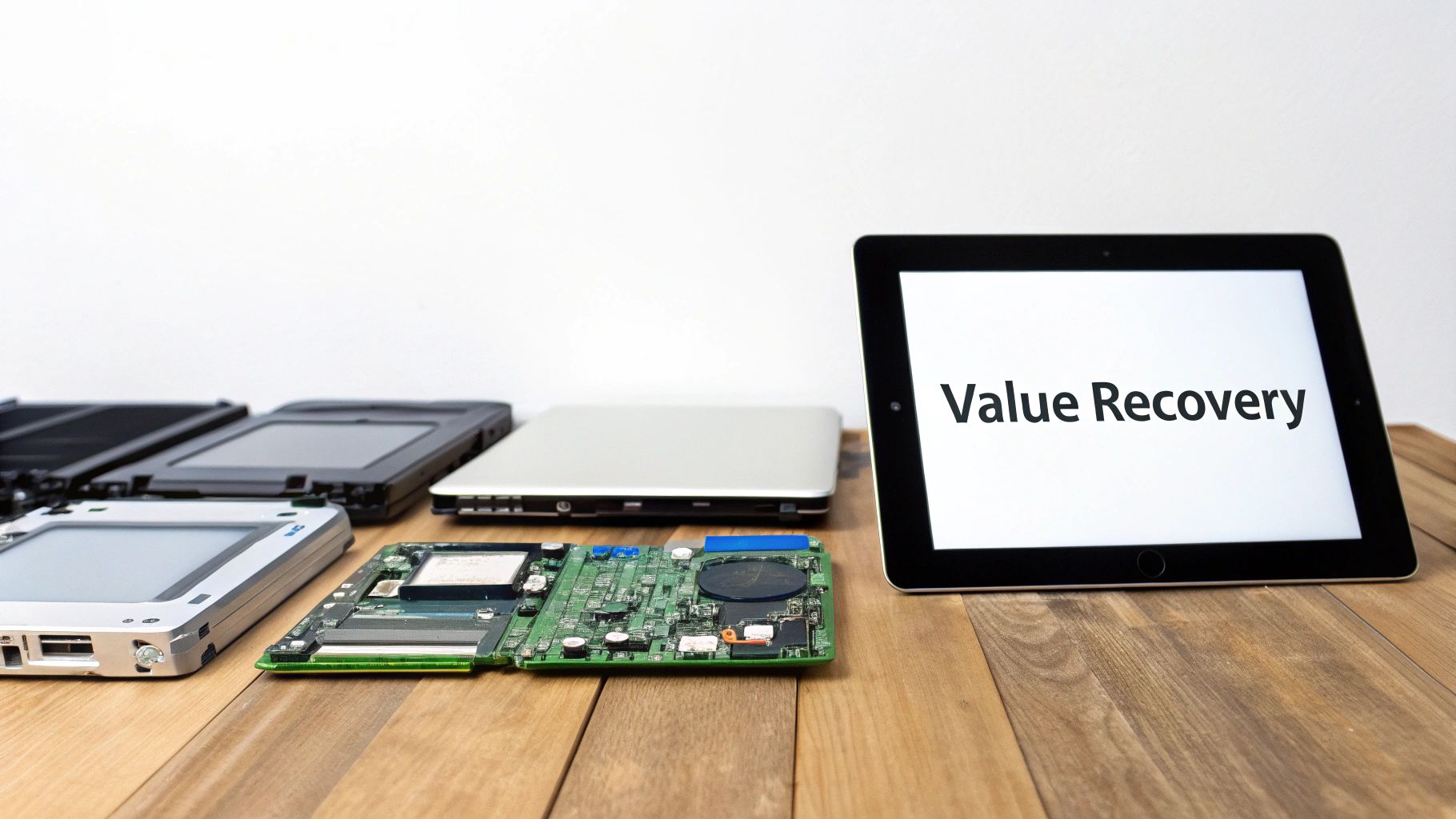
Most businesses look at a closet full of retired IT gear and see a headache. It's just a pile of hardware that costs money to store and even more to get rid of. But what if you could flip that script? A smart approach to IT asset disposition can turn that old equipment from a costly liability into a genuine revenue stream for your company.
This is the financial upside of ITAD, often called value recovery. It’s all about finding, assessing, and remarketing used technology to capture whatever market worth it still holds. Instead of paying someone to haul your old assets away, your business could actually get a check for them, recouping a nice chunk of your original investment.
How We Determine Asset Value
Not everything that gets decommissioned is destined for the recycling shredder. A surprising amount of hardware, especially enterprise-grade equipment, holds on to its value long after it’s been taken out of service. Resale potential all comes down to a careful look at a few key factors that tell us where an asset stands in the secondary market.
Our evaluation process for business assets zeros in on:
- Asset Type and Age: Newer enterprise servers, networking equipment, and recent-model laptops almost always have the highest resale potential.
- Condition: We look at each device from two angles: does it work, and how does it look? Functioning gear in good cosmetic shape will always fetch a better price.
- Component Demand: Sometimes a whole system might be obsolete, but its parts—like CPUs, RAM, and storage drives—are still in high demand. We look for those hidden gems.
- Market Trends: The secondary IT market is always shifting. Our team keeps a close eye on current demand to make sure you’re getting the best possible return for your assets at that moment.
This detailed look allows us to see past the dust and identify every pocket of value hiding in your retired inventory. And it's a growing market, which tells you more and more companies are focusing on smart, sustainable tech management.
The global IT asset disposition (ITAD) market is on track to nearly double, jumping from USD 18.7 billion in 2025 to USD 39.3 billion by 2035. That’s a compound annual growth rate of 7.7%. Servers make up the biggest slice of that pie with a 31.2% market share, proving just how important it is to manage high-value infrastructure.
Financial Models for Value Recovery
Once we’ve figured out what your business assets are worth, we have a few different financial models to fit your company’s needs. Each one offers a different mix of speed, convenience, and potential return, so you can pick the one that aligns with your bottom line. To see the full breakdown, check out our professional IT equipment buy-back services.
A strategic ITAD partner doesn't just dispose of your assets; they actively work to convert them back into capital for your business. This shifts the process from a cost center to a revenue-generating activity.
Let's break down the main ways we can structure the financials for commercial clients.
Direct Buyout
A direct buyout is the cleanest and quickest way for your business to get paid. After we assess your equipment, we'll make you a simple cash offer for the whole lot.
- How it Works: We send you a purchase offer. Once you say yes, we schedule the pickup and get your payment processed right away.
- Best For: Companies that want immediate cash flow and a fast, no-fuss transaction. You don't have to wait for anything to sell.
Consignment Agreement
If your company is willing to play the long game for a potentially bigger payout, a consignment agreement is a fantastic choice. With this model, we market and sell your assets for you.
- How it Works: We take care of all the heavy lifting—testing, marketing, and selling your equipment. You get a pre-agreed-upon percentage of the final sale price as each item finds a new home.
- Best For: Businesses with higher-value or specialized equipment that could benefit from being strategically placed in the resale market to really maximize the financial return over time.
How to Choose the Right ITAD Partner for Your Business
Picking an IT asset disposition (ITAD) partner isn't just another vendor contract. It's a critical business decision that directly affects your company's security, compliance, and even your bottom line. Think of the right partner as a shield, protecting your organization from crippling data breaches and steep regulatory fines. The wrong one? They can leave you wide open to massive risks.
This choice has become even more important as the industry booms. The data center ITAD market is on track to hit around USD 13.87 billion by 2025, growing at a rate of 6.8% each year. This growth is fueled by the explosion of cloud computing and tougher global regulations, which makes finding a certified, professional partner more crucial than ever for U.S. businesses. You can dig deeper into the data center ITAD market growth if you're curious.
Look for Gold-Standard Certifications
Certifications aren't just fancy logos for a website—they're hard-earned proof that a vendor is committed to the highest industry standards for security and environmental responsibility. They’re the non-negotiable qualifications your business should be looking for, verifying that a partner’s processes have been put through the wringer by a third-party auditor.
When you’re vetting potential partners, these are the credentials you need to see:
- R2v3 (Responsible Recycling): This is the leading standard for electronics recycling. An R2v3-certified vendor gives your business a guarantee that all electronic waste is handled in an environmentally safe way, keeping toxic materials out of our landfills.
- e-Stewards: Often seen as one of the toughest environmental certifications out there, e-Stewards ensures no hazardous e-waste gets shipped off to developing countries. It also means all recycling is done safely and ethically.
- NAID AAA Certification: This one is all about data destruction. A NAID AAA-certified partner has gone through extensive, unannounced audits of everything from their hiring practices to facility security and the data destruction process itself. It’s the ultimate peace of mind that your sensitive business information will be properly destroyed.
Choosing a partner for your business without these core certifications is like hiring an unlicensed security guard. You're handing over your most valuable assets with no verified proof they can actually protect them.
Demand a Clear and Auditable Process
Transparency is everything in a trustworthy ITAD partnership. Any reputable vendor will provide a clear, documented, and fully auditable trail for every single asset they touch. This is what we call the chain of custody.
From the moment your equipment leaves your building, your company should have complete visibility into its journey. Insist on a partner who gives you detailed, serialized reporting at every step, capped off with a final Certificate of Data Destruction. This paperwork is your legal proof of compliance and is absolutely essential for passing any internal or external audits.
Evaluating National Providers vs. Local Recyclers
So, should your business go with a huge national provider or a local recycler? The answer really depends on what your company needs. A large national company might offer a sprawling network and standardized processes, which can be perfect for a corporation with offices scattered across the country.
However, a certified local partner like Beyond Surplus can often give you more personalized service, greater flexibility, and a much better handle on regional logistics and rules. Working directly with a dedicated local expert means your business can build a stronger relationship and get a solution that’s perfectly tailored to your security needs and financial goals. The bottom line is this: no matter the size, make sure any partner you choose holds the right certifications to protect your organization.
Got Questions About IT Asset Disposition? We’ve Got Answers for Businesses.
Stepping into the world of IT asset disposition (ITAD) can feel a bit overwhelming for any business. As companies get smarter about security and their environmental footprint, they start asking some really important questions. We hear them all the time from businesses just like yours across the United States, so we've put together some straight-shooting answers to clear things up.
Think of this as your practical guide to making smart, confident decisions about your company's old tech. We'll tackle the big concerns for any commercial client: cost, data security, and exactly what kind of gear you can hand over to a professional ITAD partner.
How Much Does ITAD Cost for a Business?
This is usually the first question on everyone's mind, and the honest answer is: it depends. There’s no single flat fee for ITAD services. Instead, the final cost is shaped by a few key factors that can either add to the bill or, in many cases, put money back in your company's pocket.
Here’s what goes into the final number:
- Logistics: The cost to securely pack and transport equipment from your office to a processing facility is a major factor. Things like distance, the sheer volume of gear, and whether you need special handling for heavy data center equipment all play a part.
- Data Destruction Method: On-site shredding, where a truck comes to you, is typically more expensive because it involves mobilizing heavy machinery and a dedicated crew. Certified data wiping is often a more budget-friendly choice, especially for assets that still have resale value.
- Asset Value: This is where things get interesting for your bottom line. If your retired equipment can be resold, that money can offset—or even completely cover—the cost of the service. Sometimes, your business might even get a check from us.
- Recycling Fees: For older items with no resale value that contain hazardous materials, there might be a fee to cover the cost of responsible, compliant recycling.
It's a common myth that ITAD is just another business expense. When managed correctly with a focus on value recovery, a good ITAD program can often be cost-neutral or even turn a profit for your company.
How Can My Business Be 100% Sure Our Data Is Gone for Good?
This is, without a doubt, the most critical question for any business. A data breach is the single biggest risk when getting rid of old equipment. A simple promise that your data is gone just doesn't cut it—you need undeniable, auditable proof.
That proof comes from a Certificate of Data Destruction. A certified ITAD partner provides this legally binding document after the destruction process is complete. It’s your official record, listing every single serialized asset that was sanitized or destroyed. This certificate effectively transfers the liability for that data from your company to the ITAD vendor and is essential for proving compliance with rules like HIPAA, GLBA, and the FTC Disposal Rule.
What Kinds of Commercial Equipment Do You Take?
Companies often wonder if their specific mix of hardware is something a professional ITAD service can handle. The short answer is almost always yes. A full-service ITAD partner is equipped to manage nearly any type of electronic asset a business might use. This includes electronics recycling, computer recycling, and secure disposal services for a wide range of commercial needs.
This list covers most of it, but it's by no means exhaustive:
- Corporate IT: Laptops, desktops, servers, monitors, and networking equipment like switches and routers.
- Data Center Equipment: Server racks, storage arrays (SANs), uninterruptible power supplies (UPS), and cooling units for full data center decommissioning.
- Specialized Hardware: Medical equipment disposal, laboratory equipment disposal, and industrial control systems.
- Office Electronics: Printers, copiers, scanners, and phone systems, often handled through product destruction services.
The ITAD market is growing fast, and it’s not just a local trend. The Asia Pacific region, for example, controls over 42% of the market share in 2024. This growth is fueled by major sectors like IT, finance, government, and healthcare. The IT & telecom sector alone is projected to make up nearly 24.7% of the market by 2025. You can discover more insights about the ITAD software market on fortunebusinessinsights.com to see how these trends are shaping the industry.
On-Site vs. Off-Site Shredding: Which is Better for My Business?
Choosing between on-site and off-site hard drive shredding really comes down to your company's security policies, budget, and peace of mind.
- On-Site Shredding: This is the white-glove option. A mobile shredding truck comes right to your location, and you can physically watch your hard drives get turned into tiny metal fragments. It offers the highest level of immediate assurance and is often the top choice for highly regulated industries like finance and healthcare. It's also the more expensive option.
- Off-Site Shredding: With this method, your assets are securely transported in a locked vehicle with a documented chain of custody to a secure facility for destruction. It's still incredibly secure, more cost-effective, and you get the exact same certified result.
Both methods end with a Certificate of Data Destruction. The right choice depends on your internal risk policies and whether the comfort of witnessing the process firsthand is worth the extra cost.
Contact Beyond Surplus for certified electronics recycling and secure IT asset disposal services across the United States. Discover how our professional ITAD solutions can protect your business, ensure compliance, and find hidden value in your retired technology. Learn more at https://www.beyondsurplus.com.
